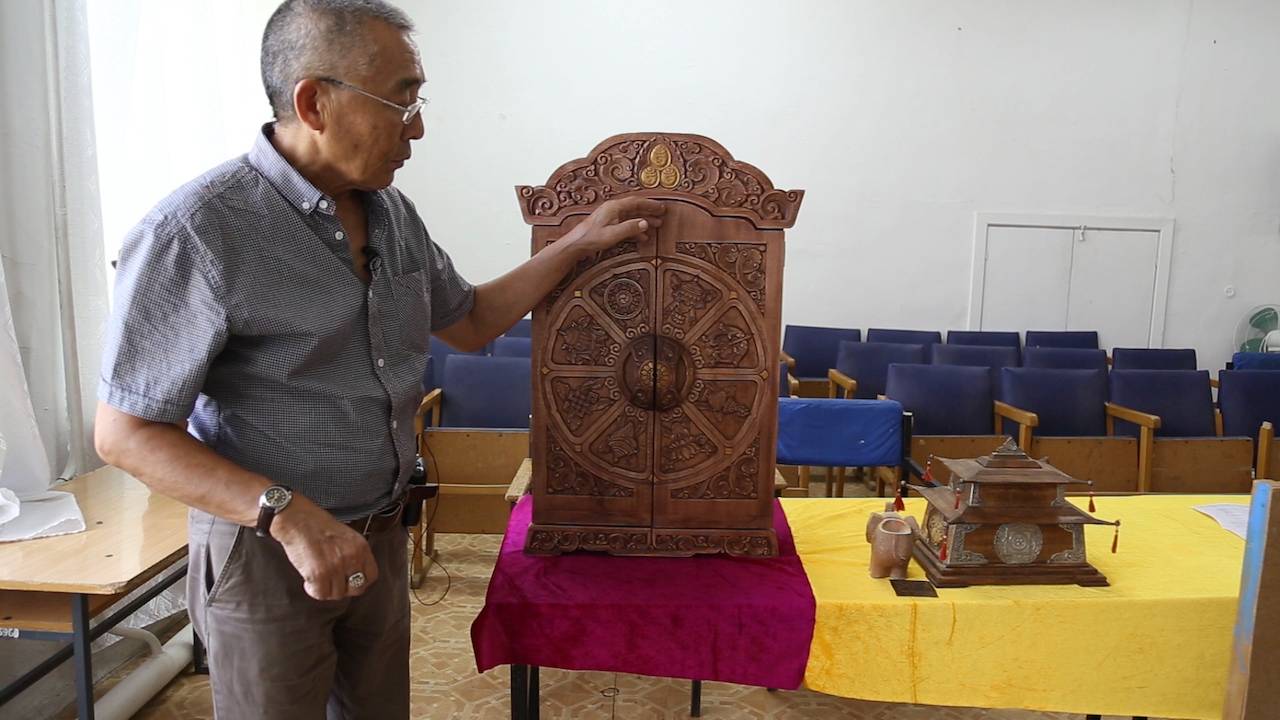Kalmyk Cultural Heritage Project (CARPENTRY and BONE CARVING)

| Created: | 2016-03-09 16:09 |
|---|---|
| Institution: | Department of Archaeology and Anthropology |
| Editors' group: | (not set) |
| Description: | Wood was an essential material for producing implements indispensable for the livelihood of nomads, including the wooden framework of the yurt, furniture (beds, trunks, chests, tables, and cradles), containers, utensils, saddles, whips, tobacco pipes, musical instruments, toys and many others. Types of wood used by Kalmyk carpenters included pine, plywood, maple, alder, oak, birch, hazel, and elm. The main techniques employed were carving, chiseling, drilling, and turning on a lathe when producing cups or containers.
Many wooden items, especially those deemed valuable or socially significant, were often decorated with ornaments made of silver, gold, or copper plate, including saddles, cups, plates, tobacco pipes, and domestic furniture. For example, until recently tobacco pipes, which were made of maple and oak, were not only indispensable for every person, men and women alike, but also carried an element of prestige, if they were refined and decorated. To render wooden items durable, Kalmyks employed several methods. For example, newly carved cups, buckets, and plates were first boiled in water, then cleaned with a felt cloth. Animal oil was applied, and then the item was kept wrapped in a felt cloth for about 10 days until the oil was absorbed. Afterwards, animal oil was applied once more and the items were dried in the sun. Another way was to boil medium-sized dishes in melted butter. Items processed in this way were known not only for their durability but were often passed from one generation to the next. Apart from wood, Kalmyks also used bones and horns for carving. The end products were combs, spoons, toys, amulets and other small objects. |
Media items
This collection contains 14 media items.
Media items
Aleksandr Koshevoi, Tobacco Pipe
14 views
Aleksandr says that the Kalmyks learnt to smoke from the Chinese. The Kalmyk pipe is made from the wood of fruit bearing trees such as the apricot, pear and cherry trees. Its...
Collection: Kalmyk Cultural Heritage Project (CARPENTRY and BONE CARVING)
Institution: Department of Archaeology and Anthropology
Created: Wed 9 Mar 2016
Anastasia Naranova, Jangar: A Carving on the Wood
21 views
Collection: Kalmyk Cultural Heritage Project (CARPENTRY and BONE CARVING)
Institution: Department of Archaeology and Anthropology
Created: Sun 3 Dec 2017
Badma Amulakova, Tobacco Pipe
19 views
Collection: Kalmyk Cultural Heritage Project (CARPENTRY and BONE CARVING)
Institution: Department of Archaeology and Anthropology
Created: Mon 2 Jan 2017
Dordzhi Nandyshev, About Whip Varieties
11 views
Dordzhi talks about whip varieties: The malya whip has a piece of lead attached to its end, which makes it a dangerous weapon. Warriors used this whip in the past.
The tashmyg...
Collection: Kalmyk Cultural Heritage Project (CARPENTRY and BONE CARVING)
Institution: Department of Archaeology and Anthropology
Created: Sat 4 May 2019
Exhibition: Carpentry and Bone Carving
34 views
This video features Kalmyk carpentry and objects made from bone that were displayed at an exhibition held at the National Museum in Elista in April 2015.
Collection: Kalmyk Cultural Heritage Project (CARPENTRY and BONE CARVING)
Institution: Department of Archaeology and Anthropology
Created: Fri 27 Jan 2017
Valeriy Ulyumdzhiev, Prayer Beads From Lotus Seeds
25 views
Collection: Kalmyk Cultural Heritage Project (CARPENTRY and BONE CARVING)
Institution: Department of Archaeology and Anthropology
Created: Thu 8 Feb 2018
Vasiliy Tsandykov, About Saddles, Bows and Throwing a Lasso
33 views
Collection: Kalmyk Cultural Heritage Project (CARPENTRY and BONE CARVING)
Institution: Department of Archaeology and Anthropology
Created: Tue 8 Aug 2017
Viktor Dordzhiev, About the Craftsmanship of the Kalmyks
26 views
Viktor says that in the past Kalmyks could produce everything that was used in nomadic life. He draws attention to the importance of setting up children’s studios to teach...
Collection: Kalmyk Cultural Heritage Project (CARPENTRY and BONE CARVING)
Institution: Department of Archaeology and Anthropology
Created: Thu 28 Apr 2016
Viktor Dordzhiev, Bone Carving: Chess
20 views
Viktor has been playing chess since childhood. He can carve chess pieces in 10 different ways or styles. The chess pieces that he shows in this video have been carved in a...
Collection: Kalmyk Cultural Heritage Project (CARPENTRY and BONE CARVING)
Institution: Department of Archaeology and Anthropology
Created: Thu 28 Apr 2016
Viktor Dordzhiev, Bone Carving: Statues, Figures and Chests
21 views
In the beginning when Viktor was learning carving skills, he mainly used cow or pig bones. In high school he used a mammoth tusk for his carvings. His first works made from a...
Collection: Kalmyk Cultural Heritage Project (CARPENTRY and BONE CARVING)
Institution: Department of Archaeology and Anthropology
Created: Thu 28 Apr 2016
Vladimir Byurchiev, Horn Carving and Processing
51 views
Vladimir teaches bone and horn carving in a secondary school in Adyk village. He learnt this traditional craft from Viktor Sataev. The most widespread type of horns used in...
Collection: Kalmyk Cultural Heritage Project (CARPENTRY and BONE CARVING)
Institution: Department of Archaeology and Anthropology
Created: Thu 9 Mar 2017
Vladimir Kuberlinov, About the Dalai Lama's Throne
14 views
Collection: Kalmyk Cultural Heritage Project (CARPENTRY and BONE CARVING)
Institution: Department of Archaeology and Anthropology
Created: Fri 2 Feb 2018
Vladimir Kuberlinov, My Carvings
21 views
Collection: Kalmyk Cultural Heritage Project (CARPENTRY and BONE CARVING)
Institution: Department of Archaeology and Anthropology
Created: Fri 2 Feb 2018
Vladimir Kuberlinov, My Students' Work
19 views
Collection: Kalmyk Cultural Heritage Project (CARPENTRY and BONE CARVING)
Institution: Department of Archaeology and Anthropology
Created: Fri 2 Feb 2018

